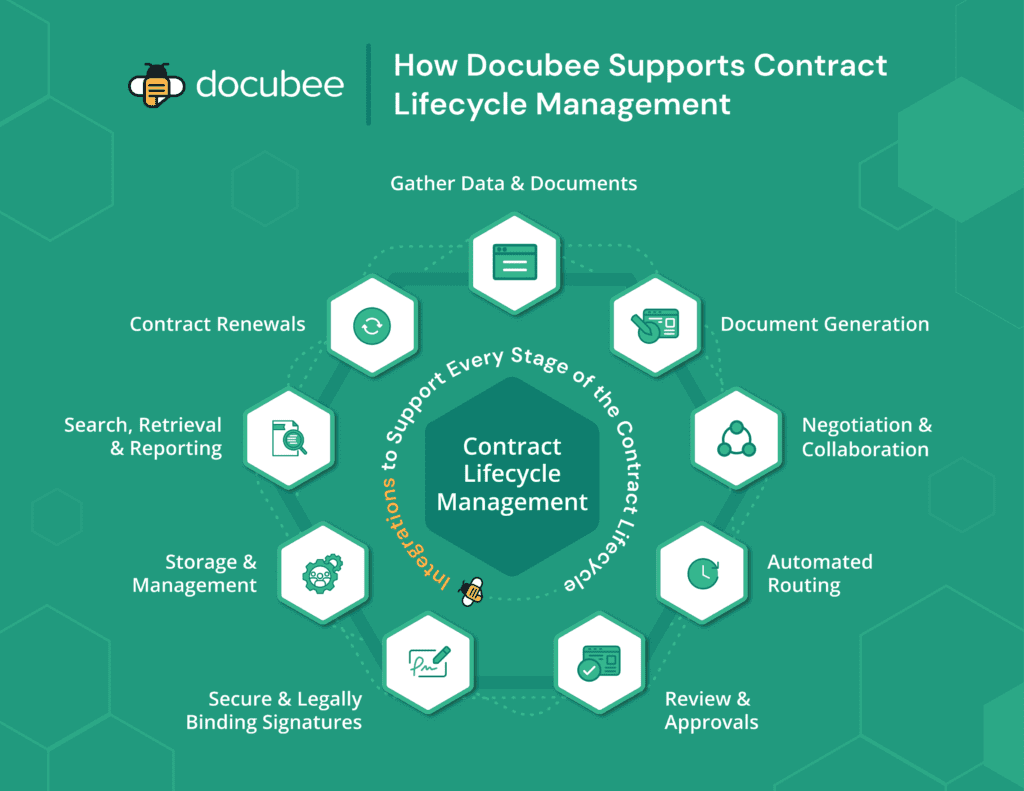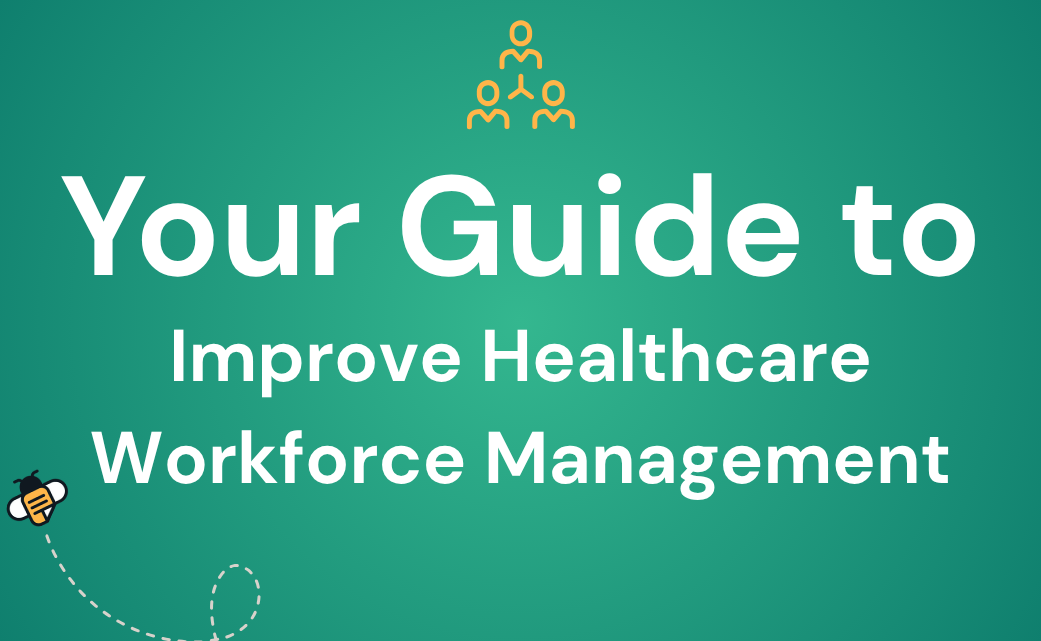It took months to bring a deal from proposal to signature. Now that you’re ready to sign on the dotted line, roadblocks caused by time-consuming manual processes threaten to stall your closing.
It’s time to step out of the past and into the future by using automation software to improve your contract management process.
Let’s review how to speed up your contract workflows without hurting security or compliance.
What is a Contract Management Process?
A contract management process is a structured approach to creating, negotiating, executing, and managing contracts throughout its lifecycle. It includes contract drafting, approval, monitoring, compliance, and renewal.
Some companies opt for manual contract management, which requires monitoring and tracking to ensure security and on-time completion. However, manual processes are often inefficient and slow, so more businesses opt for contract management automation. This uses software to create, send, track, and manage signatures.
Check out our contract automation guide to learn more.
Common Challenges Associated with Contract Management

Contract management should be a seamless process that moves with lightning speed from proposal to signing. Unfortunately, this isn’t the reality for most companies.
Let’s review some of the top challenges in dealing with contract management.
Outdated or Manual Systems
Manual contract creation. Paper-based contract management. Tracking down that final signature to close a deal. Sound familiar?
If so, you’re at the mercy of outdated or manual systems.
Paper contracts have been the backbone of company growth for decades. But it doesn’t come without its flaws. For instance, creating new contracts from scratch and ensuring they reach each individual or department is time-consuming.
And let’s not forget human errors like misspelled names, misplaced signatures, and incorrect dates.
Running a business using manual contract management is inefficient. It bogs down your team, taking away precious hours they could spend on more profitable tasks (like executing contracts).
Why manage physical copies of contracts, track changes, and ensure version control when your automation tools can do it for you?
Inconsistent Contracts
Recreating contracts for each proposal leaves room for inconsistencies. For example, terms and clauses may differ slightly from contract to contract, causing confusion and increasing the risk of errors.
Standardizing your process with templates eliminates this issue and ensures all contracts meet compliance requirements.
Little Room for Collaboration
Using paper-based contracts or sharing digital documents via email makes collaboration tough.
You have your legal team reviewing contracts, procurement personnel approving the terms, and the sales and marketing team discussing pricing. Relying on physical meetings and emails can make it difficult to communicate contract changes, delays, and other updates in real-time.
This may lead to miscommunication, misunderstandings, and contractual disputes.
Contract management often involves multiple stakeholders, including legal, c-suite, and finance teams. Poor communication and collaboration among these parties can lead to delays, misunderstandings, and increased chances of contractual disputes.
Contract Visibility and Searchability
Your team signed a contract a year ago, and it’s time for a renewal. Now, you must search through your filing system to find the original contract. Unfortunately, it’s paper-based or uses email to share digital documents.
There’s no proper indexing or metadata, so no way to speed up the search. This means you’ll spend days or even weeks searching for the contract.
Proactive Renewal and Expiration Management
Keeping track of contract expirations is critical to ensure you don’t miss an opportunity to renew. Missing the deadline could cost your company thousands of dollars in revenue.
Proper contract renewal and expiration monitoring allows you to:
- Review the contract terms and negotiate new terms and possibly even a higher price
- Terminate a service contract before it auto-renews
- Prevent service disruptions due to auto-termination after the contract expires
Ignoring contract renewal management could lead to a loss in money and valuable business relationships.
Outgrowing Past Solutions
A mom-and-pop shop with a handful of contracts can rely on manual processes. But once it grows and expands, these systems will no longer serve the business.
Companies that want to scale fast will find outdated contract management burdensome and time-consuming.
Attempting to manage dozens or hundreds of contracts using paper or PDF contracts in an email system is a disaster waiting to happen.
Essential Steps in a Contract Management Process

So, what does it take to build a proficient contract management system? Here are the steps that should be a part of every contract management process.
1) Contract Creation and Drafting
A proposal was approved by a client — now, it’s time to create the contract. During the drafting stage, you must consider factors like the terms, length of the contract, renewal dates, and so on.
Get this right the first time to prevent unnecessary revisions and back and forth that prevent closing. Or use templates to prevent repeating mistakes.
2) Contract Review
After drawing up the contract, it’s time to review it with your legal team and other stakeholders to ensure compliance and accuracy. This process could take days or weeks using manual processes.
3) Negotiation
It’s time to present your contract to the client for review. Some may accept the contract right away. Others will want to negotiate the terms and pricing.
4) Contract Approval and Signatures
Once the negotiation is complete, it’s time to get final approval and signatures from everyone involved. This may include the CEO, vendors, and other stakeholders.
5) Contract Execution and Implementation
A signed contract is ready to go. If you’re the service provider in the contract, you must begin performing the tasks you promised.
6) Monitoring and Compliance Management
If your contract outlines that a vendor must perform an analysis and send you a monthly report, then your team must monitor the vendor to ensure compliance. Same goes for any terms and conditions in the contract that must be met.
7) Documenting Changes and Amendments to Contracts
Sometimes, you need to change a contract to meet your growing needs. For instance, you’re scaling your operations and need a vendor to perform additional services. You’ll need to document the changes in the contract and ensure everyone agrees and signs.
8) Renewal or Termination of Contracts
At the end of the contract, you’ll either renew it as is, renegotiate, or terminate it. This happens at the end of the contract, or before an expiration date. For instance, you may decide to terminate a contract after a 90-day trial period. If you’re not careful, you can miss these important dates, especially when using manual processes to track expiration dates.
9) Analysis and Reporting
Department managers must analyze the contract performance to determine if it’s meeting the company’s expectations. Then, they’ll develop a report discussing why keep or terminate it.
Best Practices for Enhancing the Contract Management Process
Your contract management process is clear, but is it efficient and infallible? Not likely.
Here are best practices to reduce errors and streamline the process.
Create Standardized Contract Templates
Creating the perfect contract takes time. It requires reviewing all the terms, conditions, and clauses with stakeholders, which can take weeks. Once you perfect it, why start over from scratch with the next contract?
With templates, you can standardize your contract process, prevent errors, and save time.
Centralize Contracts in One Repository
Sending contracts via email was lightning-speed compared to snail mail. But it’s not an efficient tool for sending and signing contracts, especially with multiple recipients. Trying to keep track of who signed what and when is an unnecessary bottleneck you can eliminate using a centralized repository.
Everyone, including external vendors, has access to this repository to review and sign contracts in one location. In other words, no more tracking down signatures.
Use a Contract Automation Solution to Streamline Operations
When you want a fast and simplified digital contract management process, you need a solution that removes repetitive tasks and integrates with your business applications. Contract automation solutions streamline your operations by removing redundant tasks and integrating with your business applications.
For example, you can go from proposal to signed contract in several steps. Automation software saves your templates, so you can access them from anywhere on any device. Just fill in the blanks (e.g., names, dates, unique terms and conditions), and send it to all stakeholders within seconds.
Then sit back and wait for everyone to sign.
When you purchase the right automation software, it’ll integrate with your existing applications (e.g., CRMs and procurement management solutions), so handling contracts is fast and secure.
Learn more about the other benefits of contract management automation.
Adopt a Contract Lifecycle Management (CLM) Platform
Using software to manage the lifecycle of your contracts makes it easier for everyone to stay on top of contract processes from start to finish.
For example, a CLM empowers you to:
- Create contracts from scratch or use templates (premade and custom) for speed and control
- Manage a library of pre-approved clauses to ensure consistency and prevent missing key terms
- Receive alerts and notifications when contracts are ready for signature or are complete
- Share a single location for all contracts to make signing and approvals fast
- See a complete audit trail of changes and versions for all contracts
You’re always in control, thanks to the high-level visibility and granular tracking of CLM software.
Conduct Regular Process Reviews and Audits
After adopting contract automation software, it’s still critical to conduct regular process reviews and audits. There’s only so much platforms can do — your team must still ensure compliance and efficiency.
Evaluating the performance of manual and automated contract processes will identify bottlenecks and inefficiencies so you can address them immediately.
Invest in Staff Training and Skill Development
Contract management software does a lot of the heavy lifting, but your team must know how to use it to its full potential. Take time to develop resources, such as knowledge hubs, to educate team members about your contract management processes and software. It’s also a reason to select a platform that’s intuitive, user-friendly, and offers live support.
For example, Docubee provides online chat, weekly office hours, self-help articles, and recorded webinars to get you up to speed and ensure you’re using the platform effectively.
Set Up Alerts and Notifications for Contracts
No more chasing down signatures and approvals. With automation software, you can assign roles so contracts are routed to the appropriate stakeholders to prevent bottlenecks.
In your dashboard, you’ll see who’s next in line to approve or sign a contract, so you can reach out to them directly to keep the flow moving along.
Enhance your Contract Management Process Now
Don’t allow your deals to fall through due to slow, inefficient contract processes. Docubee keeps your team buzzed about what’s happening throughout the contract pipeline.
This includes the ability to create, manage, sign, and track digital contracts.
If you’re ready to fly through contracts, schedule a demo of Docubee today.


















